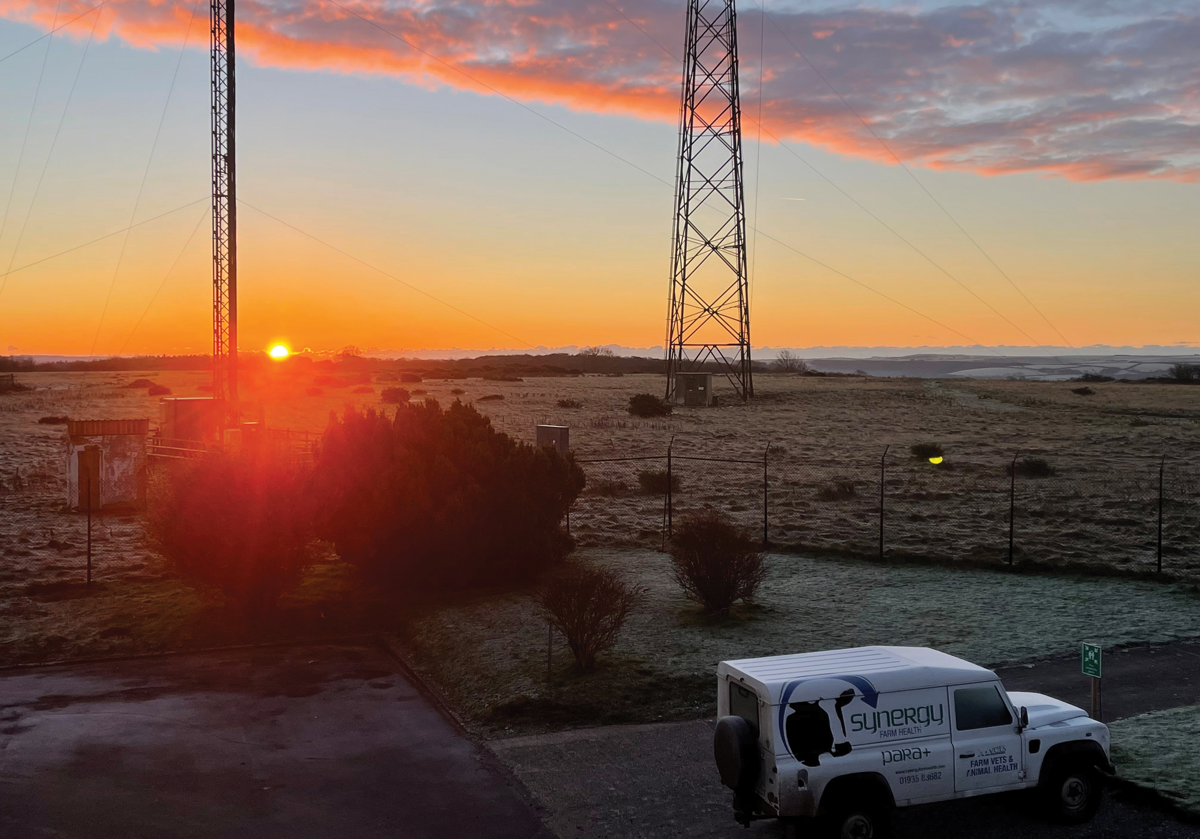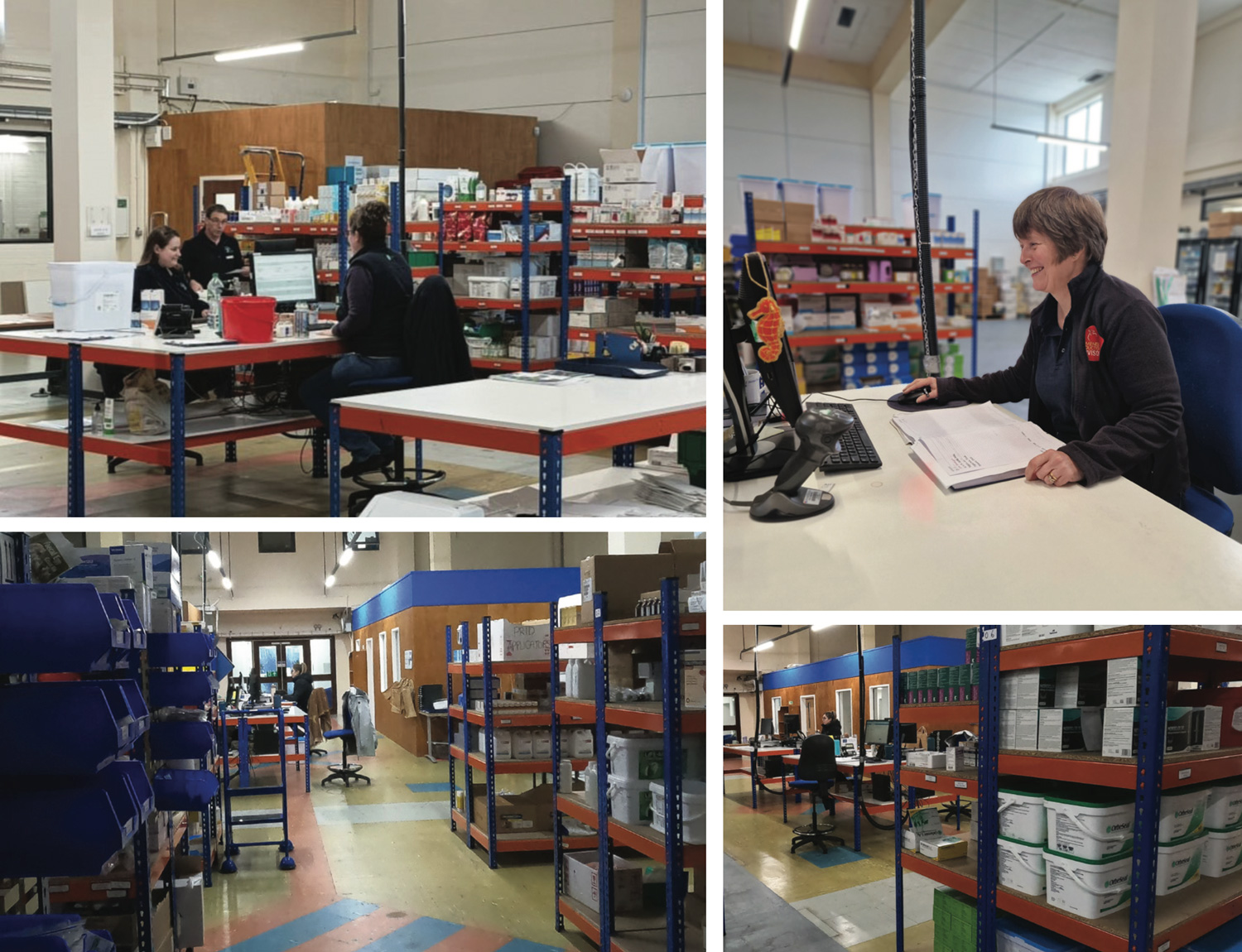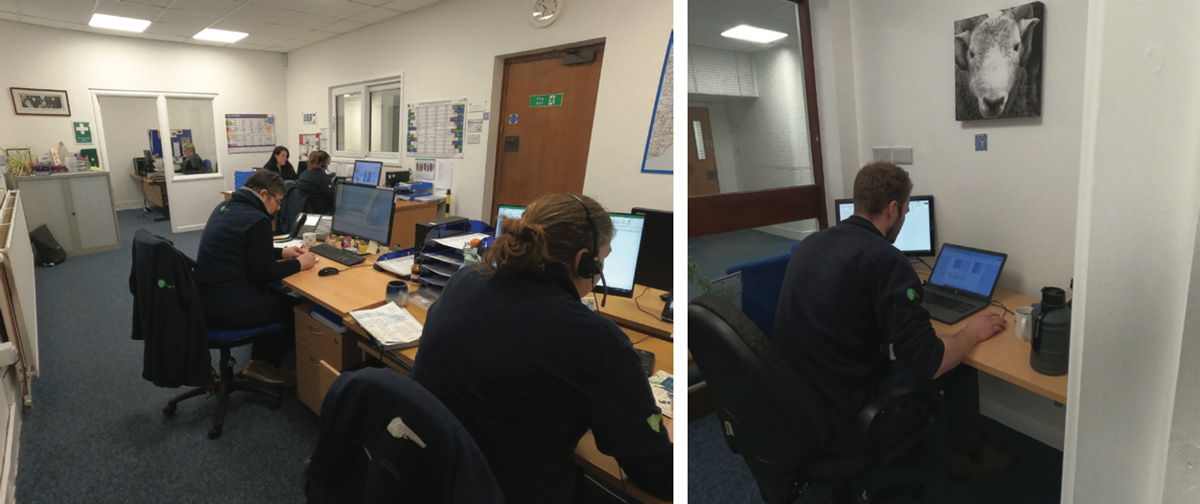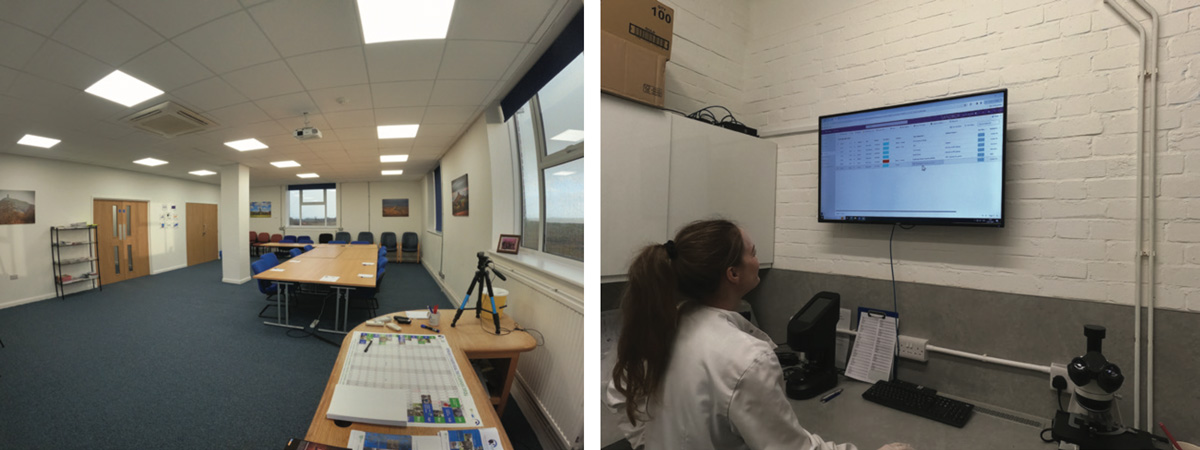1 Feb 2024
Synergy Farm Health was formed when two neighbouring West Country practices decided to merge their farm departments in 2009. Since then, Synergy has grown rapidly and is now the UK’s largest independent farm animal practice, as VBJ discovered when we paid a visit last month…

Synergy Farm Health, Rampisham Business Centre, Rampisham, Dorset
Staff: full-time vets (including interns and residents) 29 • part-time vets 14 • veterinary technicians 20 • TB testers/ATTs 12 • TB testers/ATTs 47
Empire building wasn’t really part of the plan when the farm animal partners at Kingfisher Veterinary Practice in Crewkerne and Southfield Veterinary Centre in Dorchester proposed a merger of their farm departments in 2009. The veterinary world was changing rapidly at that time and the days of the traditional mixed practice looked to be numbered.
They were confident that letting their respective small animal businesses become separate was the right move for both sides, allowing the farm vets to join forces with a similar-sized neighbouring farm vet practice to allow a focus on modern preventive health care for the farm sector. They believed this would be good for the practice and for its clients – and they were right.
Over the next decade they were joined by the clients of other mixed practices exiting the farm sector – from Honiton, Langport, Axminster and Glastonbury. The clinical team now serves farm clients from Exeter to within sight of the New Forest and on to Salisbury Plain, taking in large swathes of prime dairy country in east Devon, Dorset, Somerset and Wiltshire.
Growth happened organically over a number of years, according to marketing director Ed Powell-Jackson, a 2006 University of Cambridge graduate who has been with the practice since the start of his career.
He said: “In each case, the retiring vets came to us, saying their practice’s appetite to continue in the farm animal sector had gone as senior vets retired – would we like to acquire the farm client base? They wanted their long-standing and loyal clients to be well looked after, by a practice which shared their values, and one that they knew would do a good job into the future.”
The number of vets has grown from the initial 15 to 42, with 20 vet technicians among a total staff of 122. Vets’ time is primarily focused on dairy cattle, with smaller (but growing) emphasis on progressive sheep and beef work, as well as the occasional alpaca. Commensurate growth has been seen in the practice’s annual turnover, which for the first time this year broke through the £10 million barrier.

Corporate practices have taken an increasing share of the UK market in farm vet services, just as in the small animal sector. But Synergy is still entirely owned by its employees.
Ed explained: “We think that being independent allows us to be agile in setting the practice business strategy and allows us to respond to the changing market. We want to provide career progression and a route into business ownership for our staff. And we want to keep it that way.”
In many respects, the practice is now a hybrid model, halfway between an old-style partnership and a corporate structure. At the start, the original shareholders were the six partners from the two parent practices. However, over time, the shareholder group has grown, including but not limited to, the senior vets, and now includes Jo Masters – its operations director (an RVN) – and two of the vet technicians. This means many individuals now have a stake in the future of the business, which aids liquidity, but more importantly helps in succession planning.
Providing clinical services over such a large area of the south-west does present considerable challenges. To ensure realistic journey times, and to maintain client continuity and staff job satisfaction, the clinical workforce is divided into four teams of 8 to 10 vets – the western group based around Axminster, the central team around Dorchester, the northern section around Crewkerne, and the eastern division in and around Salisbury.

The management of the practice has inevitably become more complex as the business has grown. The strategic board – responsible for long-term decision-making and business strategy – consists of an independent chair, some of the senior vets/shareholders, and several non-executive directors from outside the business, who have wide expertise in relevant allied areas, such as agriculture or the feed industry.
The management board, chaired by managing director Jon Reader (an RCVS cattle specialist who has also spent his whole career at the practice), comprises departmental heads and is the engine room of the practice. It meets monthly and is responsible for key management decisions.
The practice headquarters were originally in the quaint Dorset village of Evershot, roughly halfway between the two parent practices, but moved in July 2022 to an industrial estate a couple of miles away – the former site of the BBC World Service’s Rampisham transmitter station, which closed in 2011.
The building houses all the main functions for a company of this size – management, finance, marketing and IT – and some that are vet specific, such as reception, an in-house lab with two technicians, and a large scale and impressive dispensary that organises medicine deliveries to farm, as well as to various collection points across the practice geography. But other than a post-mortem room for examining the carcases of sheep and calves (adult cattle are handled at a nearby knacker’s yard), there are no clinical facilities at the main site.
The work of each of the four vet and vet tech teams is organised at the headquarters – clients all use the same telephone number to book visits, with a dedicated receptionist for each region. The reception staff are all familiar with the geography of the particular area they are responsible for.
They communicate with the ambulatory staff by mobile phone, having recently put out to grass the CB radio technology that they had used for many years.
Company vehicles are all equipped with trackers that allow reception staff to monitor their movements and direct the nearest vet to any emergency (and also to facilitate proper booking out of vet time on farm).
One of the benefits of developing into a larger business is the company now has sufficient critical mass to be able to employ internal expertise to handle different business functions. So, now the practice has a full-time IT technician, David Proctor, while Julian Gwynn was recruited to manage the company fleet of 75 vehicles and Jade Ellis RVN oversees the management of the dispensary. In his job as marketing director, Ed has three colleagues who take care of internal communications, the company’s presence at numerous agricultural shows over the summer, the company website and social media, allowing him to continue to his interest in clinical work.
The work of bovine practitioners has evolved in the past few years, with a steady reduction in “fire brigade” calls. Ed said: “Much of our work is preventive and preplanned, rather than reactionary. With our considerable depth of veterinary expertise, we have always felt that we have more to offer than just doing the traditional work of a dairy practice. Indeed, it has been a business strategy to diversify beyond traditional vet work.”

Providing consultancy to milk buyers is one of the newer income streams that have opened up for progressive farm practices. Some of Synergy’s senior vets, several of whom are RCVS specialists in cattle health, travel throughout the country visiting the farms that supply supermarket chains like Waitrose and Sainsbury’s to advise on animal welfare and herd productivity.
The practice also has contracts with pharmaceutical and animal feed companies, organising trials of new products and techniques. One of the senior vets, Rachel Hayton, now works full time in coordinating these research projects.
But much of Ed’s clinical work consists of preplanned visits for routine health and fertility checks on dairy farms, varying in size from 60 to 600 cows.
“Dairy farmers are generally much more knowledgeable and better trained than in the past,” he said.
“They can handle many of the issues that vets used to be called out for. But the quality of stockmanship does vary considerably and we have clients across the whole spectrum.”
The company’s cadre of veterinary technicians were originally employed to carry out foot trimming, both for its own clients’ herds and to those of neighbouring vet practices, but their role now extends far beyond this. The technicians offer a portfolio of livestock services, to include foot trimming, locomotor scoring, calf disbudding, freeze branding, vaccination and artificial insemination to name just a few.
Ed said: “They play a hugely important role in our business, and I don’t just mean financially – lameness in dairy cattle is such a vital issue, not just because of its impact on productivity and reproductive efficiency, but as an animal welfare concern and a wider potential public relations problem for the dairy industry.
“The public quite rightly don’t want to see animals that are clearly in discomfort, and reducing the prevalence is a major goal of our team.”

The vet techs work closely with the vets, providing a unique team approach to analysing herd lameness data and developing strategies to address the problem. Ed said: “Our foot trimmers are very popular with our clients; not only are they highly skilled professionals but they have a similar agricultural background and they speak the same language.”
Synergy’s vet techs are trained to industry leading standards; indeed, some have now achieved a standard at which they themselves are asked to lecture to colleagues around the country.
Teaching has always been part of the skill set for farm vets, but Ed says that during his career, this aspect of the work has become more significant, is better organised and now makes an important contribution to the practice finances.
Synergy has a formal contract with the RVC to teach the practical component of the final-year farm animal undergraduate training. This applies to a cohort of around 280 students, and so groups of around a dozen are studying at Synergy throughout the year. The practice’s old premises at Evershot has been redeveloped to provide the students with first-class teaching facilities and accommodation.
The teaching follows a formalised curriculum agreed between the RVC and Synergy staff. This includes practical training out on the farm, but with seminars and workshops held at one of the Synergy sites. Teaching duties are pre-booked in the diary for the clinical staff involved and are regarded as an important part of their working day. “This is very different to traditional EMS where the experience and teaching could vary considerably,” he said.

Synergy also runs formalised postgraduate training programmes in conjunction with the RVC. Two new graduates, with aspirations of a career in farm practice, spend a one-year internship fully embedded in the Synergy team. This arrangement, now in its 13th year, has been highly successful. In addition, Synergy now operates a residency programme in conjunction with the RVC, using the joint resources of the RVC and Synergy to prepare two residents for the rigours of European diploma examinations in bovine or small ruminant specialities. All of this demonstrates the practice’s commitment to the future of the farm animal sector.
An added bonus of the schemes has been to facilitate recruitment, so often a thorn in the side of many practices. Ed said: “It gives both sides a chance to see if there is a good fit and many of our ex-interns have gone on to do very well here and become highly valued members of our team. Tom Warboys, who won British Dairying magazine’s Young Dairy Vet of the Year competition in 2023, was one of our interns and remained with us.”
Growing your own vets also helps solve another managerial headache for any large veterinary business – succession planning. Ed said: “Where appropriate we encourage these talented young clinicians to become shareholders in the company, and over time provide training and support for them to progress to managerial roles.
“We know a young vet will have debts from tuition fees, purchasing a house and may soon be wanting to start a family. So, we try to make business ownership affordable – by helping to facilitate finance for share purchases, for example, and being continually mindful of the business valuation and share price. Our properties are rented rather than owned, for example.
“As for the management of the practice, we firmly believe this should be a matter of having the right person with the right skills in the job, rather than the default option of whoever has been here the longest.”